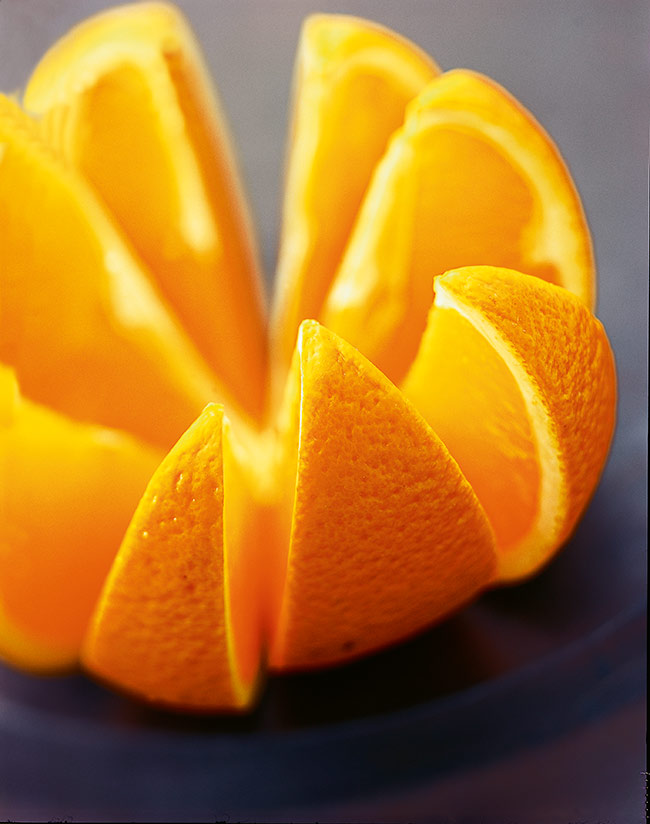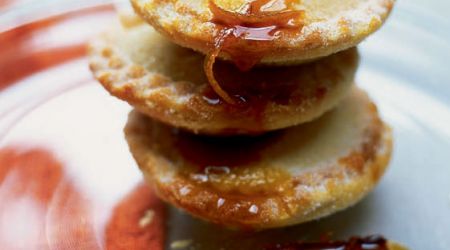Oranges
From ancient China to the British breakfast table, in 6,000 years. Helen Hokin charts the rise and fall of one of the oldest fruits of all with recipes by Linda Tubby
We can be a right lazy lot sometimes. In fact, we’ve sent sales of oranges plummeting in the last three years because, apparently, we can’t be bothered to peel them anymore. Right then, time for a reminder as to why this sunny winter fruit deserves more attention. To recap: the orange has ancient lineage – it was first cultivated in China 6,000 years ago. At the turn of the first millennium, English crusaders in the gardens of Jaffa depended on it for its thirst- slaking juice. In 1801, The War of the Orange even took on its name, for goodness sake! And if that’s not enough, how about this: it’s the main ingredient in our beloved breakfast marmalade. But what was once the eagerly anticipated treasure at the bottom of a Victorian Christmas stocking has, alas, taken a nosedive down the popularity polls.
We haven’t gone off the flavour. We’re a nation of OJ guzzlers and go simply weak at the knees for any chocolate-orange combo – be it an ice cream, mousse or bar. Come to think of it, we’ve never been too short on time to peel back the tin foil on a chocolate orange. And when it comes to nutrition, it seems we’d rather force down horse tablets in the name of Vitamin C intake than find ourselves the real thing, which doesn’t add up when you think that oranges eaten whole out of the hand deliver a much more complex and vital set of nutrients than any tablet or juice.
Oranges have come a long way. From China, Arab traders brought the golden orbs to the Mediterranean and North Africa. They crossed the Strait of Gibraltar into Spain with the Moorish invasion where, ever since, Andalusia has been synonymous with the squat evergreen tree. Adorning patios throughout the region, its delicate blossom scent fills the balmy air while its branches bear fruit at the same time. Whether due to its golden colour or exotic provenance, it soon became a symbol of wealth. In Italy, the Medici family adopted five golden balls, known to be oranges, for their family coat of arms. France took its first delivery of this emblem of prosperity when the Duke of Bourbon brought a tree back from Spain. When he later defected to Italy the covetous King Francois I seized the tree. Later, Louis VI, with his pioneering attitude to horticulture and magpie-like attraction to all things that glittered, took himself and the tree off to Versailles and cultivated a grove – the ultimate personal symbol of status and wealth.
However, the story so far only concerns the bitter orange – what we today call the Seville. With flesh too bitter to eat raw, its oils, extracted from the blossom and skin, were the cause of all the excitement. Alluring Neroli oil might have been the perfume of choice among European royals but, on home turf, medieval Brits remained dubious as to the benefits of a hot, scented bath. So while they bathed we cooked. Marmalade.
By the 18th century the bitter-sweet orange preserve dominated our breakfast table and further uses for the fruit evolved from there. Georgian cookery books, for example, include recipes for baked orange puddings calling for the peel and juice of Seville oranges. In France, bigarade was concocted – a dark, port-enriched, orange-flavoured sauce served with roast duck – and orangettes, those divine chocolate-coated candied orange peels from Provence.
The arrival of its sweet cousin boosted our Vitamin C intake for good. Enterprising Christopher Columbus hauled roots off to Hispaniola starting cultivation across the Caribbean, Mexico and South America. Large-scale commercial farming began in Florida and California in the 1870s and 1880s when the Americans grew and then exported their first shipment – 10,000 boxes of oranges – to England in 1892.
At this time of year our oranges come from the northern hemisphere: Spain, Morocco, Cyprus, Egypt and Turkey. If the tiny stickers telling of provenance and variety have until now passed you by then take a closer look. Are you eating or juicing? In February and March, dessert oranges include the Navel Late and Lane Late, which are dead easy to peel. The Sanguinello and Morata, both blood oranges, are considered the sweetest and most delicate. Salustianos and Valencias are for pressing, positively loaded with rich, golden juice. Pick up a couple of net bags, squeeze enough to fill a large jug and give Sunday brunch the Midas touch. Whole Seville oranges freeze well although they come apart when defrosted, but that doesn’t matter if you’re about to pile them into a pan for a batch of marmalade.
Do not let a little green or russetting of the skin put you off – these are as ripe and ready as solid orange-coloured ones. Those with soft spots or traces of mould should be avoided along with spongy-to-the-touch or light-weighted ones. Choose oranges that have smoothly textured skin, those that are firm and heavy for their size will have a higher juice content. The smaller the fruit the juicier it’s likely to be.
Oranges go well with almonds, carrots, milk, dark chocolate, cardamom, duck and game but, ultimately, their juicy, sweet flesh and refreshing citrus burst on the tongue is best savoured on its own. So, for any lapsed peelers out there, now is the time to embrace the real, unadulterated thing: research conducted at Food and Travel magazine can confirm it takes approximately 27 seconds to peel a Navel Late. So go on, give it a go – for old time’s sake. Stage a contest. Who can get the peel off fastest and, better still, all in one piece?

Recipes
Get Premium access to all the latest content online
Subscribe and view full print editions online... Subscribe


